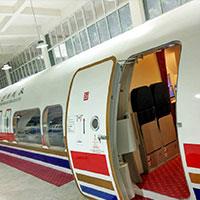Introduction to common standard external lighting systems in aircraft simulation cabins
Common standard external lighting systems for aircraft simulation cabins:
1. Red anti-collision lights: installed in the upper and lower middle of the aircraft, one for each. The purpose is to prevent aircraft from colliding. This light will burst and flash at a certain frequency according to the controller adapted to the model. and open when the engine is running.
2. Wing lights: 2 single-beam lights located on each side of the wing, illuminating the leading edge of the wing and the engine air intake. It is used to check the icing situation. This light should be turned on when there is a possibility of icing, but the actual application Normally open.
3. Navigation and marking lights: Navigation lights: red on the left, green on the right, and white on the tail vertebrae are installed on the wing tip and tail catch respectively. It is used to identify the flying object as an aircraft and indicate the flight direction. The marking lights are respectively installed on the two sides On the wingtip of the horizontal stabilizer, it provides lighting for the airline logo on the vertical stabilizer. Airbus aircraft has 2 sets of navigation lights, and its LOGO light is when the main landing gear shock absorber strut is compressed or the flaps are extended more than 15 degrees When the indicator light is on, the navigation light must be turned on as long as there are people on the plane.
4. Head light: This light is installed on the front landing gear, and the two lights are called take-off light and taxi light. When placed in the TO position, both the take-off light and taxi light are on, and when placed in TAXI, only the taxi light is on. This light is used For the front lighting of taxiways and runways, put it in the TAXI position when the aircraft is taxiing, and put it in the TO position after entering the runway. It will be turned off after the aircraft takes off. When the front landing gear is retracted, it will be automatically turned off.
5. Landing light: This light is installed on the wing roots of the two wings, two on the left and one on the left. It is used to illuminate the runway when taking off and landing. This light has a large power and generates a lot of heat when used, so it needs high-speed airflow for cooling. Therefore It can only be opened before taking off from the ground.
6. Runway departure lights: Installed on the shock absorbing struts of the front landing gear, one on the left and one on the left, respectively providing lighting on the two sides in front of the nose. It is used to illuminate the taxiway and the sideline of the runway. It is turned off after take-off. Automatically when the front landing gear is retracted Closed. Open after starting the engine, another purpose is to signal the ground crew to prepare to slide out at night
7. High-brightness white strobe light: This light is installed on the front and back of the wing tip and one on the tail cone. The Boeing aircraft is installed on the left and right wings and one on the tail cone. There are 3 lights in total. The Airbus aircraft is installed on the There are 5 left and right wings, front and rear wingtips and tail cones. The purpose is to prevent aircraft from colliding. This light will burst and flash at a certain frequency according to the controller adapted to the model, and the brightness is very high.


